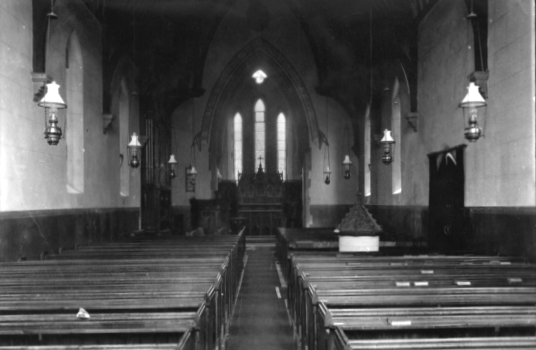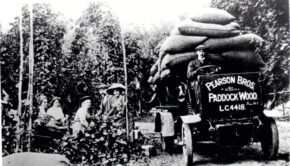The Blitz: A Plan for London and a future for Paddock Wood
During September 1940, the year St Andrews Church in Paddock Wood was destroyed, Luftwaffe pilots were equipped with maps identifying areas to target with their bombs.
The one that hit the church, however, was thought to be accidental!
For four and a half years Britain, and particularly London & the South East, endured the physical and psychological consequence of air attack: fear, shock, the loss of loved ones, deprivation, destruction of property and potential of defeat. It was a national ordeal which laid its mark deeply within those who endured it.
In spite of the times and considering what else there was to worry about, it seems remarkable that a detailed plan was devised for the future of the County of London. The year was 1941 and the work was prompted by Lord Reith and commissioned by the Council from Mr J H Foreshaw, an architect and Patrick Abercrombie Professor of Planning at University College London.
The creation of that vision draws parallels with a situation today in the area of Paddock Wood. Traditional buildings have been destroyed, large scale housing is planned and the Town Centre faces radical change.
In a city blitzed by bombs and with no end in sight there was a spirit of optimism where an opportunity for development was recognised.
The London plan formed a very large and complex document illustrating ideas of order, efficiency, beauty and spaciousness.
In 1945 a smaller version of the work was published for clarity and ease of understanding .
E J Carter, a librarian, and Erno Goldfinger were commissioned and it was published by Penguin.
The book appeals to the reader to pay attention and think – as this will affect their lives.
The message has as much relevance today as it did then….
“It may be good to have a plan but a big idea has very little chance of being carried out if there is not behind it the pressure of real necessity” they said. “Once established from a bewildering mass of facts and figures expert analysis is required to recognise how to move forward”.
Even in 1945 it was recognised that residents see enough to know what is wrong although it takes “considerable understanding of the life and character of an area to know exactly what is wrong and what exactly is needed.”
Carter & Goldfinger pose the question “Why a Plan”? They emphasise the need to ask and consult the people to discover the answer:
“in their homes, their hospitals, their offices, in the schools, in the playground, in the streets, in the car park, in the traffic jam”.
Traffic congestion, housing, inadequate distribution of open space as well as jumble of housing and industry and sprawl were identified as issues to be resolved.
A problem facing any aspirations lay in powers of execution. Without lawful powers to act (eg. aquire land to build roads) any attempts were destined to become piecemeal. Even then it was recognised that Government must provide powers to enable plans to be carried out.
Although our towns belong in a vague sort of way to us…the actual terra firma belongs to private or corporate landowners as well as local authorities. A range of interests must be considered … a major challenge to those with a vision and yearning for change.
“No less important than exercise of control over new building is care for the fine architecture that has survived from the past”
The London plan explains that a new London does not mean our inheritance of beautiful orderly streets and terraces, palaces and wealth of churches can be “ruthlessly and unthinkingly swept away by enthusiastic new developers. The loveliness of a fine building need never be in conflict with the efficiency and modernity of the new if the new building recognises the quality of the old and is designed in an orderly way to fit in with it”
Those who redesigned post-war Paddock Wood probably didn’t quite grasp all that! Most of its fine original buildings were flattened.
Local authorities had little control over that stray bomb on St Andrews Church..but afterwards with precision that would put the Luftwaffe to shame, Paddock Wood endured a blitz of its own.
In no particular date order: Down went two former schools. One was Listed Building and the other in Old Kent Road. Down went the Parochial Hall, The Old Pumping Station, Railway cottages & residences in Commercial Road including the former Nurses’ Bungalow and a Pair of Villas.
Down went the Railway Hotel, the Station Masters House and not forgetting a beautiful Railway Building sited on the north platform. Down went the ARP building, dwellings at Whites Corner, The Factory Chimney, the old Grain Store,
In 2003 MP John Prescott announced a Communities Plan to deal with shortage of housing in the south. He was pressed about infrastructure lagging behind and responded that it would be “stupid” to put a date on starting developments before making key decisions about that. “The private sector is not going to invest unless we put the infrastructure in. They are not daft.”
People in Paddock Wood today are still concerned about infrastructure, albeit perhaps they are missing an exciting opportunity? Enterprising folk might target the tourist industry with visionary plans for water sports or a Little Venice in Paddock Wood Town Centre!
As ideas evolve for the future we can hope to save survivors from the Paddock Wood Blitz including Pubs, Mascalls Manor, the Wesley Centre and heed those words from the London plan.
From the destruction of the war years came new optimism and vision. We have to move on yet again but it remains to be seen how well it will all be delivered.






Comments